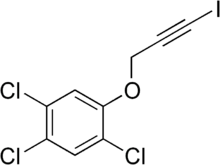Haloprogin
"Polik" redirects here. For other uses, see Polik (disambiguation).
 | |
| Systematic (IUPAC) name | |
|---|---|
|
1,2,4-trichloro-5-[(3-iodoprop-2-yn-1-yl)oxy]benzene | |
| Clinical data | |
| Legal status |
|
| Routes of administration | Topical |
| Identifiers | |
| CAS Number |
777-11-7 |
| ATC code | D01AE11 |
| PubChem | CID 3561 |
| DrugBank |
DB00793 |
| ChemSpider |
3440 |
| UNII |
AIU7053OWL |
| KEGG |
D00339 |
| ChEMBL |
CHEMBL1289 |
| Chemical data | |
| Formula | C9H4Cl3IO |
| Molar mass | 361.39 g/mol |
| |
| |
| Physical data | |
| Melting point | 113.5 °C (236.3 °F) |
| Solubility in water | insoluble mg/mL (20 °C) |
| (verify) | |
Haloprogin is an antifungal drug used to treat athlete's foot and other fungal infections. It is marketed in creams under the trade names Halotex, Mycanden, Mycilan, and Polik.
Action
Haloprogin was previously used in 1% topical creams as an antifungal agent. It was marketed over the counter primarily to treat tinea infections of the skin. The mechanism of action is unknown.[1]
Haloprogin had a high incidence of side effects including: irritation, burning, vesiculation (blisters), scaling, and itching. It has since been discontinued due to the emergence of more modern antifungals with fewer side effects.[2]
References
- ↑ "Haloprogin". Drugs@FDA. Food and Drug Administration. Retrieved 2007-02-17.
- ↑ "Haloprogin". DrugBank. University of Alberta. Nov 6, 2006. Retrieved 2007-02-17.
This article is issued from Wikipedia - version of the Friday, September 04, 2015. The text is available under the Creative Commons Attribution/Share Alike but additional terms may apply for the media files.